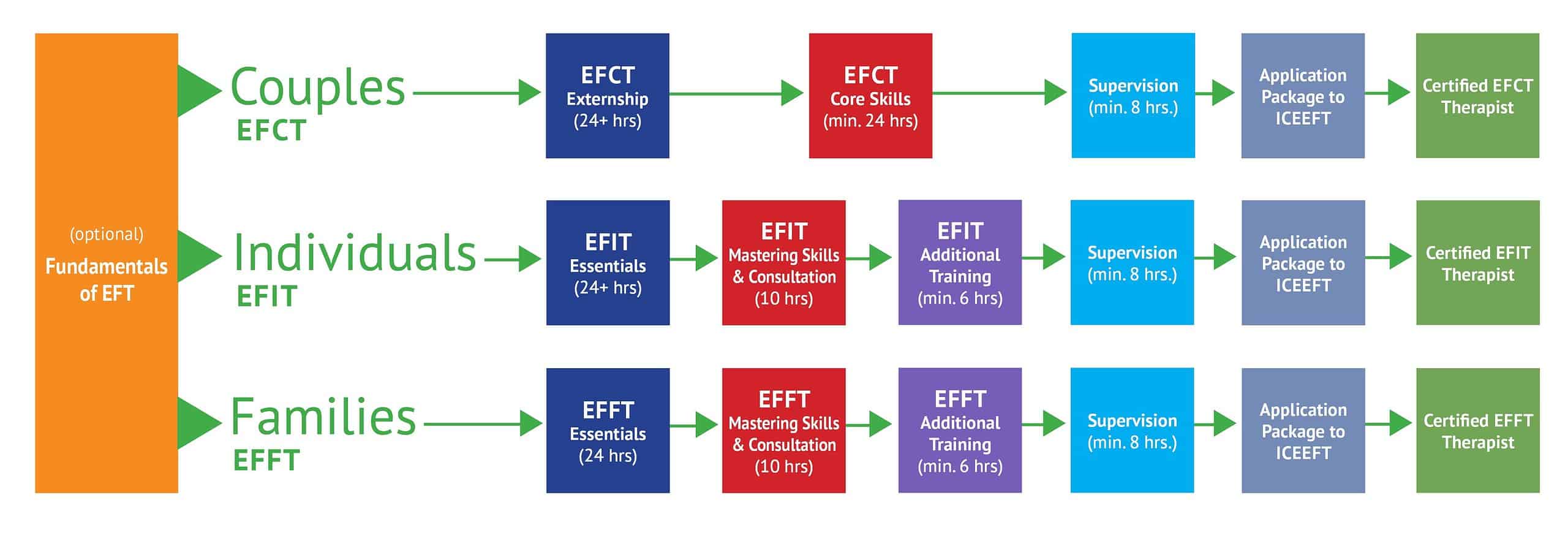Path to ICEEFT Therapist Certification in EFT
As of January 2024, ICEEFT offers therapist certification in EFCT (EFT for Couples), EFIT (EFT for Individuals), and EFFT (EFT for Families).
More detailed information about how to certify in each modality is available on their overview pages:
– For Emotionally Focused Couple Therapy (EFCT) click here.
– For Emotionally Focused Individual Therapy (EFIT) click here.
– For Emotionally Focused Family Therapy (EFFT) click here.
Detailed information about trainings, certification requirements and processes, and much more are available on the members’ website.

GENERAL OVERVIEW OF SKILLS REQUIRED FOR EFT CERTIFICATION
Learning and integrating the EFT model includes development of the following skills. This list can be used as a guideline to assist supervisors and applicants to assess for readiness for certification. Additional specific details and information for certification in each EFT modality (EFIT, EFCT & EFFT) are available on the ICEEFT members website.
Alliance Skills
Therapist readily demonstrates…
- Attunement and empathic tracking of client’s experience.
- A safe-haven alliance (A.R.E.) including assessing risk, context, and contraindications.
- A focus on reactive patterns and validating client’s attachment strategies.
- Effectively engaging with clients in all their diversity, including the negative impact of discrimination along with clients’ strengths and resilience.
Micro Skills
Therapist shows ability to …
- Reflect and validate client’s experience and identify emotions and relational patterns.
- Validate vulnerabilities and coping strategies, normalizing blocks.
- Ask evocative open-ended questions that help identify patterns and elicit deeper emotions and underlying attachment fears and longings, encouraging self-reflection.
- Make appropriate empathic conjectures that validate and deepen experience (e.g. self/other).
- Use all micro skills together with RISSSSC prosody – slow, specific, soft, etc.
- Heighten experience with images and client’s emotional handles, where appropriate.
- Reframe experience – mostly in terms of attachment-related emotions.
- Evoke emotional experience and choreograph engaged encounters/enactments.
- Pace risk-taking appropriately, holding client within the leading edge (e.g. window of tolerance).
Tango Skills
Therapist shows ability to …
- Move 1: Identify relational patterns and affect regulation processes leading to self-perpetuating cycles.
- Move 2: Assemble Emotion – Pinpoints trigger, perception, body sensation, meaning and action tendency by focusing on and processing core emotions.
- Move 2: Distill emotion with RISSSSC and engages present experience in highly focused manner.
- Move 3: Set up encounters/enactments that prompt new awareness and /or bonding experience.
- Move 4: Process encounters (from Move 3) with client(s).
- Move 5: Summarize progress in the session, validating growth and contrasting new interactions with previous patterns.